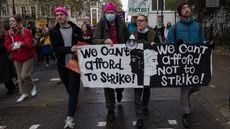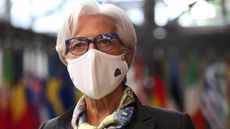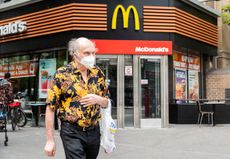Four myths about Scotland’s banks and the financial crisis
There are a lot of ‘nonsensical myths’ doing the rounds about the banking crisis in Scotland. Guest blogger Nick Reid looks at the truth behind four of them.
There are a huge number of numerically nonsensical myths doing the rounds of the Scottish independence debate at the moment, writes guest blogger Nick Reid. A good many of them are being put forward by the pro-separation group Business for Scotland.
We could spend forever going through them, but here I just want to concentrate on a few of the ones surrounding the banking crisis in Scotland. Below, I have put the points made by Business for Scotland in bold and then done a little debunking beneath.
Myth: The UK paid £66bn to bail out RBS & HBOS, but do you know that the US Federal Reserve contributed £285bn to the RBS and £115bn to the HBOS bailout packages?
Subscribe to MoneyWeek
Subscribe to MoneyWeek today and get your first six magazine issues absolutely FREE

Sign up to Money Morning
Don't miss the latest investment and personal finances news, market analysis, plus money-saving tips with our free twice-daily newsletter
Don't miss the latest investment and personal finances news, market analysis, plus money-saving tips with our free twice-daily newsletter
Reality: This is an attempt to make it look as if global central banks joined with the UK in bailing out the commercial banks. But it confuses the actual cost to the UK tax payer in recapitalising the near-bankrupt RBS & HBOS, which amounted to £66bn, and the actions of Central Banks around the world, led by the US Federal Reserve, in providing short term liquidity during the crisis.
The latter central bank monetary operations to provide liquidity did not incur a cost to the taxpayer in the same way as the former. The £66bn spent on recapitalising RBS & HBOS was a real cost to the UK taxpayer, which it may never recoup.
Scotland's GDP is £150bn. Had it been left to come up with this £66bn alone, its budget would have been utterly swamped. That would have meant a loan from friendly governments or the IMF.
Myth:The H in HBOS stands for Halifax, which isn't in Scotland by the way.
Reality: In 2006, HBOS secured the passing of theHBOS Group Reorganisation Act 2006.The act allowed HBOS to make the Governor and Company of the Bank of Scotland a public limited company, Bank of Scotland plc, which became the principal banking subsidiary of HBOS. Halifax plc transferred its undertakings to Bank of Scotland plc, and although the brand name was retained,Halifax then began to operate under the latter's UKbanking licence.The Bank of Scotland is headquartered at North Bank Street (named after the bank moving there in 1806) in Edinburgh, not Halifax.
Myth: Barclays, a London registered bank, received £552bn from the Federal Reserve and £6bn from the Qatari royal family, and nothing at all from the UK government.
Reality: Again, this confuses short-term liquidity injections from central banks and actual recapitalisation packages for bankrupt institutions. Unlike RBS or HBOS, Barclays wasn't facing bankruptcy, hence it didn't need an equity injection from the UK government. The £552bn was liquidity (no cost to taxpayers), and the £6bn an investment from the Qataris.
Myth: Let's regulate the banks in an independent Scotland so that they can't fail.
Reality: Banking regulation is decided at an international level through agreements such as the Basel Accords, which set standards on capital adequacy, stress testing and market liquidity risk. If Scottish banks wish to operate in the global markets, they need to comply with international standards, not domestic ones.
RBS's demise wasn't due to poor regulation, but because of poor management, misunderstanding of basic banking practice, and over expansion. RBS's failure is down to Fred Goodwin and his senior management team headquartered in Edinburgh.
-
 British Airways revamps Avios scheme bringing down flight prices to £1
British Airways revamps Avios scheme bringing down flight prices to £1With the new Avios part-payments scheme you can now bag a British Airways flight for as little as £1
By Oojal Dhanjal Published
-
 RBS to close a fifth of branches
RBS to close a fifth of branchesRoyal Bank of Scotland plans to shut 18 branches across Scotland, resulting in the loss of 105 jobs. We have the full list of closures.
By Ruth Emery Published
-
 Beating inflation takes more luck than skill – but are we about to get lucky?
Beating inflation takes more luck than skill – but are we about to get lucky?Opinion The US Federal Reserve managed to beat inflation in the 1980s. But much of that was down to pure luck. Thankfully, says Merryn Somerset Webb, the Bank of England may be about to get lucky.
By Merryn Somerset Webb Published
-
 Rishi Sunak can’t fix all our problems – so why try?
Rishi Sunak can’t fix all our problems – so why try?Opinion Rishi Sunak’s Spring Statement is an attempt to plaster over problems the chancellor can’t fix. So should he even bother trying, asks Merryn Somerset Webb?
By Merryn Somerset Webb Published
-
 Young people are becoming a scarce resource – we should value them more highly
Young people are becoming a scarce resource – we should value them more highlyOpinion In the last two years adults have been bizarrely unkind to children and young people. That doesn’t bode well for the future, says Merryn Somerset Webb.
By Merryn Somerset Webb Published
-
 Ask for a pay rise – everyone else is
Ask for a pay rise – everyone else isOpinion As inflation bites and the labour market remains tight, many of the nation's employees are asking for a pay rise. Merryn Somerset Webb explains why you should do that too.
By Merryn Somerset Webb Published
-
 Why central banks should stick to controlling inflation
Why central banks should stick to controlling inflationOpinion The world’s central bankers are stepping out of their traditional roles and becoming much more political. That’s a mistake, says Merryn Somerset Webb.
By Merryn Somerset Webb Published
-
 How St Ives became St Tropez as the recovery drives prices sky high
How St Ives became St Tropez as the recovery drives prices sky highOpinion Merryn Somerset Webb finds herself at the epicentre of Britain’s V-shaped recovery as pent-up demand flows straight into Cornwall’s restaurants and beaches.
By Merryn Somerset Webb Published
-
 The real problem of Universal Basic Income (UBI)
The real problem of Universal Basic Income (UBI)Merryn's Blog April employment numbers showed 75 per cent fewer people in the US returned to employment compared to expectations. Merryn Somerset-Webb explains how excessive government support is causing a shortage of labour.
By Merryn Somerset Webb Published
-
 Why an ageing population is not necessarily the disaster many people think it is
Why an ageing population is not necessarily the disaster many people think it isOpinion We’ve got used to the idea that an ageing population is a bad thing. But that’s not necessarily true, says Merryn Somerset Webb.
By Merryn Somerset Webb Published